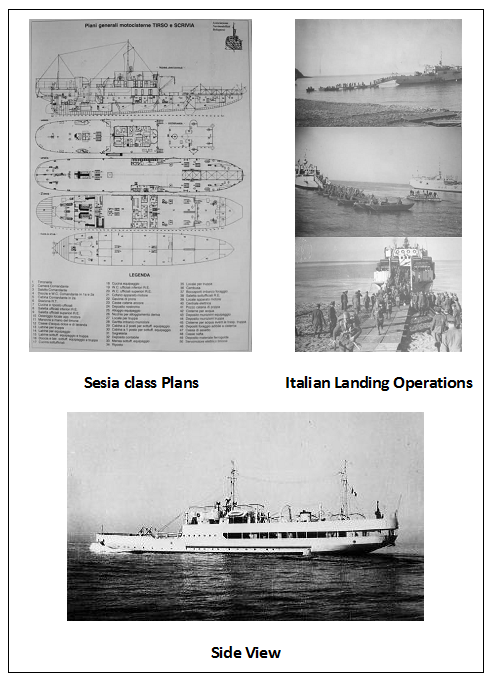In doing some research on German amphibious vessels, I came across some data on an Italian landing vessel with which I was unfamiliar. I thought I would summarize what I found and share.
-----
The
Sesia class landing ships of the Italian
Regia Marina were officially classed as water tankers (
Motocisterne per Acqua) in an attempt to disguise their intended purpose. The
Sesia carried out amphibious exercises at Massawa in 1937, at which time their true purpose became known to British and French naval authorities.
The class comprised four ships, all named for rivers of Italy. The
Sesia and
Garigliano were laid down in 1933 and commissioned in 1934; the
Tirso and
Scrivia followed three years later. An initial prototype, the
Adige, had been built in 1927-29, but deficiencies in the design of the
Adige – too narrow a gangway, too little engine power – necessitated the design of the larger
Sesia class.
The official displacement of the vessels is quoted as 1,460 tons full load, and the official dimensions are given as 65 meters length, 19 meters beam and 3.4 meters draught – which is sort of an average, as you can see from the drawings. The draught forward was approximately 0.5 meters, but aft it might be as much as 4.2 meters. Power was supplied by a pair of marine diesel engines rated at 300-315 horsepower, for a top speed of only 10.5 knots. Radius of action is quoted as 5,000 miles at 6 knots, or 2,700 miles at 10 knots.
For self-defense the ships were originally armed with and four 13.2mm machineguns; by 1939 this had been modified to two 20mm/65 light antiaircraft guns and three 8mm machineguns. They could be fitted for minelaying and carry up to 118 mines. The design was provided with an electrically operated bow ramp 2.7 meters wide and 13 meters long. Provision was made to accommodate troops (29 officers, 44 NCOs, 989 men and 50 mules) plus light tanks. Design features included a ballast tank aft which would be flooded to reduce draught forward and a disappearing rudder under the forward portion of the ship.
The
Sesia and the
Garigliano were employed in the Italo-Abyssinian War of 1935-36 in the Red Sea, and in April 1939 all four were employed in the Italian invasion of Albania. They would have been employed in a landing on Corfu by the so-called
Forza Navale Speciale, but the intended operation was called off due to bad weather. They were prepared for participation in the abortive Operation
Herkules – the planned invasion of Malta, but were involved in the occupation of Corsica in November 1942. They were subsequently employed in ferrying Italian troops to Tunisia.
The
Sesia survived the war, and was retained in the Italian Navy until June 1972. The
Garigliano was taken over by German forces in September 1943 and eventually employed as the minelayer
Oldenburg – eventually to be scuttled in April 1945 at Genoa; she would be raised, repaired and restored to service under her old name, surviving until 1952. The
Scrivia was scuttled at La Spezia by her crew to keep her out of German hands and broken up. The
Tirso remained in Italian service until 1948, when she was handed over to France a reparations and commissioned as
Hérault, surviving until the late 1950s.

